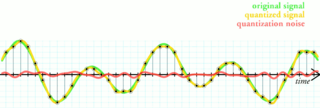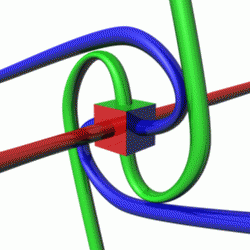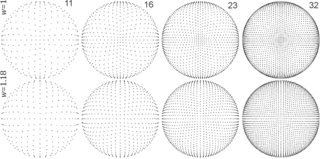
In physics and mathematics, the dimension of a mathematical space is informally defined as the minimum number of coordinates needed to specify any point within it. Thus, a line has a dimension of one (1D) because only one coordinate is needed to specify a point on it – for example, the point at 5 on a number line. A surface, such as the boundary of a cylinder or sphere, has a dimension of two (2D) because two coordinates are needed to specify a point on it – for example, both a latitude and longitude are required to locate a point on the surface of a sphere. A two-dimensional Euclidean space is a two-dimensional space on the plane. The inside of a cube, a cylinder or a sphere is three-dimensional (3D) because three coordinates are needed to locate a point within these spaces.
Quantization is the process of constraining an input from a continuous or otherwise large set of values to a discrete set. The term quantization may refer to:
Vector quantization (VQ) is a classical quantization technique from signal processing that allows the modeling of probability density functions by the distribution of prototype vectors. Developed in the early 1980s by Robert M. Gray, it was originally used for data compression. It works by dividing a large set of points (vectors) into groups having approximately the same number of points closest to them. Each group is represented by its centroid point, as in k-means and some other clustering algorithms. In simpler terms, vector quantization chooses a set of points to represent a larger set of points.
In mathematics, a symplectomorphism or symplectic map is an isomorphism in the category of symplectic manifolds. In classical mechanics, a symplectomorphism represents a transformation of phase space that is volume-preserving and preserves the symplectic structure of phase space, and is called a canonical transformation.

Quantization, in mathematics and digital signal processing, is the process of mapping input values from a large set to output values in a (countable) smaller set, often with a finite number of elements. Rounding and truncation are typical examples of quantization processes. Quantization is involved to some degree in nearly all digital signal processing, as the process of representing a signal in digital form ordinarily involves rounding. Quantization also forms the core of essentially all lossy compression algorithms.
Cinepak is a lossy video codec developed by Peter Barrett at SuperMac Technologies, and released in 1991 with the Video Spigot, and then in 1992 as part of Apple Computer's QuickTime video suite. One of the first video compression tools to achieve full motion video on CD-ROM, it was designed to encode 320×240 resolution video at 1× CD-ROM transfer rates. The original name of this codec was Compact Video, which is why its FourCC identifier is CVID. The codec was ported to Microsoft Windows in 1993. It was also used on fourth- and fifth-generation game consoles, such as the Atari Jaguar CD, Sega CD, Sega Saturn, and 3DO. libavcodec includes a Cinepak decoder and an encoder, both licensed under the terms of the LGPL.
In computer science, learning vector quantization (LVQ) is a prototype-based supervised classification algorithm. LVQ is the supervised counterpart of vector quantization systems.

Posterization or posterisation of an image is the conversion of a continuous gradation of tone to several regions of fewer tones, causing abrupt changes from one tone to another. This was originally done with photographic processes to create posters. It can now be done photographically or with digital image processing, and may be deliberate or an unintended artifact of color quantization. Posterization is often the first step in vectorization (tracing) of an image.
Harmonic Vector Excitation Coding, abbreviated as HVXC is a speech coding algorithm specified in MPEG-4 Part 3 standard for very low bit rate speech coding. HVXC supports bit rates of 2 and 4 kbit/s in the fixed and variable bit rate mode and sampling frequency of 8 kHz. It also operates at lower bitrates, such as 1.2 - 1.7 kbit/s, using a variable bit rate technique. The total algorithmic delay for the encoder and decoder is 36 ms.

In science fiction, hyperspace is a concept relating to higher dimensions as well as parallel universes and a faster-than-light (FTL) method of interstellar travel. Its use in science fiction originated in the magazine Amazing Stories Quarterly in 1931 and within several decades it became one of the most popular tropes of science fiction, popularized by its use in the works of authors such as Isaac Asimov and E. C. Tubb, and media franchises such as Star Wars.
The Linde–Buzo–Gray algorithm is an iterative vector quantization algorithm to improve a small set of vectors (codebook) to represent a larger set of vectors, such that it will be locally optimal. It combines Lloyd's Algorithm with a splitting technique in which larger codebooks are built from smaller codebooks by splitting each code vector in two. The core idea of the algorithm is that by splitting the codebook such that all code vectors from the previous codebook are present, the new codebook must be as good as the previous one or better.

Asteroids Deluxe is a multidirectional shooter arcade video game with monochrome vector graphics released in April 1981 by Atari, Inc. It is the sequel to Asteroids and was designed to combat the saucer-hunting strategy of the original allowing experts to play for extended periods. These modifications made it significantly more difficult and less accessible to players. Ports of Asteroids Deluxe were released for the BBC Micro in 1984 and the Atari ST in 1987.

In quantum mechanics, spin is an intrinsic property of all elementary particles. All known fermions, the particles that constitute ordinary matter, have a spin of 1/2. The spin number describes how many symmetrical facets a particle has in one full rotation; a spin of 1/2 means that the particle must be rotated by two full turns before it has the same configuration as when it started.
Microsoft Video 1 or MS-CRAM is an early lossy video compression and decompression algorithm (codec) that was released with version 1.0 of Microsoft's Video for Windows in November 1992. It is based on MotiVE, a vector quantization codec which Microsoft licensed from Media Vision. In 1993, Media Vision marketed the Pro Movie Spectrum, an ISA board that captured video in both raw and MSV1 formats.
In theoretical physics, the BRST formalism, or BRST quantization denotes a relatively rigorous mathematical approach to quantizing a field theory with a gauge symmetry. Quantization rules in earlier quantum field theory (QFT) frameworks resembled "prescriptions" or "heuristics" more than proofs, especially in non-abelian QFT, where the use of "ghost fields" with superficially bizarre properties is almost unavoidable for technical reasons related to renormalization and anomaly cancellation.

Solar Quest is a monochrome vector arcade game created by Cinematronics in 1981. It was designed and programmed by Scott Boden, who previously worked on Star Castle. It had a home release for the Vectrex system in 1982.
In mathematics and physics, vector is a term that refers colloquially to some quantities that cannot be expressed by a single number, or to elements of some vector spaces.

In physics, a gauge theory is a type of field theory in which the Lagrangian, and hence the dynamics of the system itself, do not change under local transformations according to certain smooth families of operations. Formally, the Lagrangian is invariant.
QuickTime Graphics is a lossy video compression and decompression algorithm (codec) developed by Apple Inc. and first released as part of QuickTime 1.x in the early 1990s. The codec is also known by the name Apple Graphics and its FourCC SMC. The codec operates on 8-bit palettized RGB data. The bit-stream format of QuickTime Graphics has been reverse-engineered and a decoder has been implemented in the projects XAnim and libavcodec.

Pyramid vector quantization (PVQ) is a method used in audio and video codecs to quantize and transmit unit vectors, i.e. vectors whose magnitudes are known to the decoder but whose directions are unknown. PVQ may also be used as part of a gain/shape quantization scheme, whereby the magnitude and direction of a vector are quantized separately from each other. PVQ was initially described in 1986 in the paper "A Pyramid Vector Quantizer" by Thomas R. Fischer.








